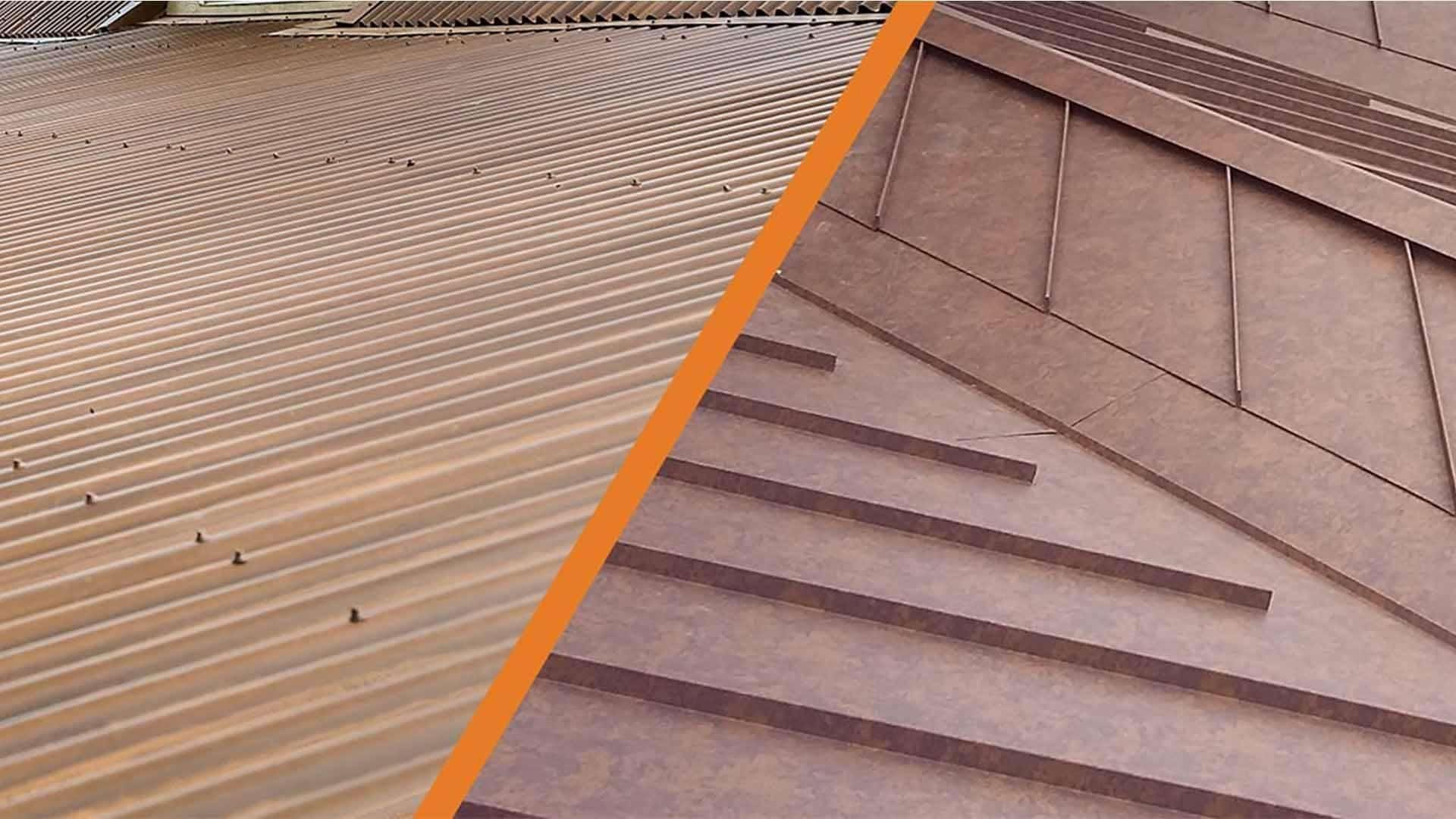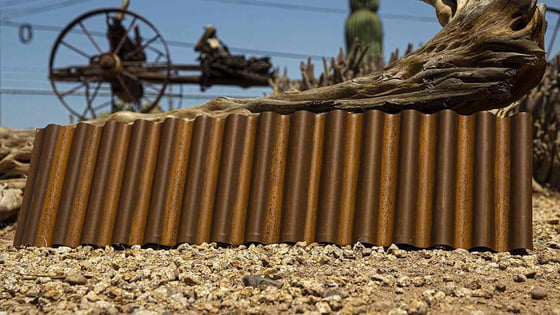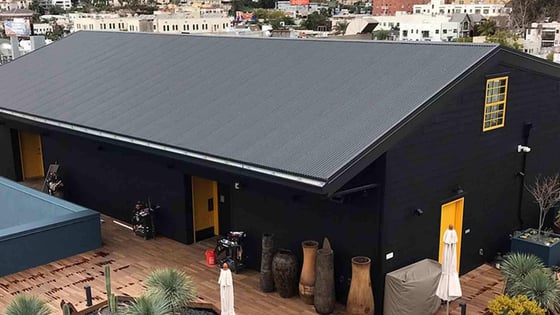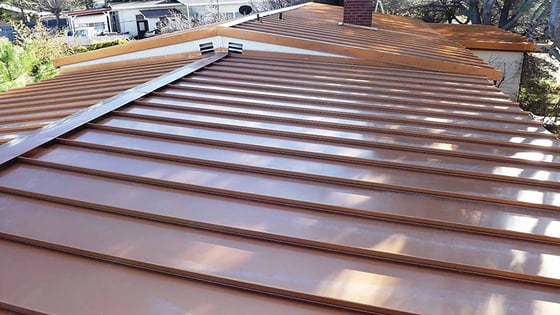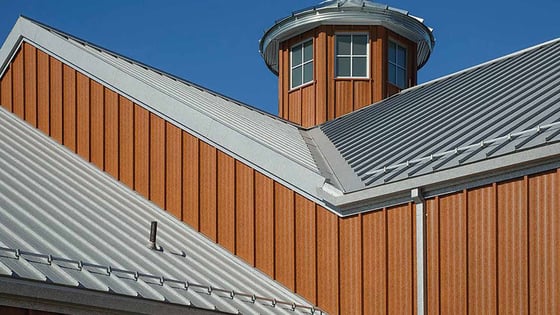Corrugated Metal Roofing v. Standing Seam (Pros & Cons)
Corrugated Roofing | Standing Seam | Panel Profiles | Pros and Cons
The two most popular metal panels on the market are corrugated and standing seam. A corrugated metal roof consists of a formed metal sheet with alternating curved and wavy ribs. The edges of each panel overlap and then are fastened down together. It’s an exposed fastener panel which means the fasteners penetrate the panel.
A standing seam roof features panels consisting of a formed metal sheet with vertical ribs at the panel edges, installed by lapping and interlocking edges of adjacent panels. The panels are attached to the substrate using concealed clips and fasteners. The screws don’t penetrate the panel.While they’re both exceptional products with similarities, there are a few key differences in both style and performance that have to be considered when comparing these panel types.
Advantages of Corrugated Metal Roofing
Comparing these panels side by side, you’ll see the main benefit of corrugated panels is the price.
Corrugated Panels Are The Most Affordable Metal Roofing
Corrugated panels are the most economical metal panels on the market and have a similar price range as asphalt shingles. Generally, corrugated metal roofing panels cost half as much as standing seam.
There are many variables that will affect the cost of the panels and they are explained in this article: How Much Does Corrugated Metal Roofing Cost?(Pricing & Factors)
Corrugated Metal Roofs Have A Fast And Affordable Installation
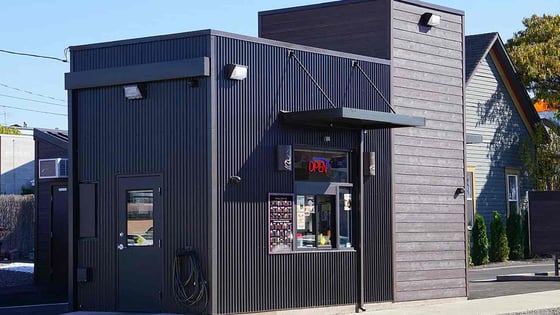
Installing corrugated metal roofing panels requires less of a skillset and is usually easier than standing seam. Since it’s a simpler job, the installation is also less expensive on corrugated panels. Typical installation costs of corrugated are about fifty percent less than standing seam.
It’s always recommended to hire an experienced contractor to install your panels. However, if you are looking for a DIY (do-it-yourself) project, it’s much easier to work with corrugated panels.
Corrugated Roofs Show Less Signs Of Oil Canning
Oil canning, or stress wrinkling, is the waviness that appears on a metal roof. This condition can occur on metal panels that have a flat surface. While it does not affect the metal’s performance, it can be an eyesore. However, on a corrugated roof, the panels have been roll-formed and the corrugations act as stiffening ribs that will control the oil canning.
Disadvantages of Corrugated Metal Roofing
There can be some potential performance issues with corrugated panels compared to standing seam.
Corrugated Metal Has Less Weather Tightness
The main disadvantage of a corrugated metal roof is that it’s an exposed fastener panel. This means that thousands of fasteners penetrate the panel to keep the roof in place. All of these penetrations in the roof leave a chance for moisture to get in. If the fasteners are not properly installed or become loose, the roof can be vulnerable to leaks.
Corrugated Panels Require More Maintenance Than Standing Seam
Although metal roofing generally does not require maintenance, they should be inspected every year to prevent any problems from developing further.
Since the fasteners are exposed on these panels, the fasteners need to be checked and possibly tightened during inspection to avoid leaks. Foam closures should also be checked at this time to make sure they are still in good condition. The roofs should also be checked for leaf buildup and cracked sealant.
Minimum Roof Slope
Corrugated metal roofing requires a minimum roof slope of 3” in 12”. It is not intended for a low slope roof.
Corrugated Metal Gauge
The higher the metal gauge, the thinner the material. Corrugated panels are usually made with a 29 to 26 gauge metal, whereas a standing seam is usually 22 to 24 gauge. This means corrugated panels are usually thinner.
If you are in an area that often experiences harsh weather such as high winds, hail, and heavy rain, then you should be looking for the thickest (lowest gauge) panel you can find. Corrugated panels will be readily available in 24 and 26 gauge. If you are looking for a lighter 29 gauge or a heavier 22 gauge it may be more difficult to find.
For help deciding what gauge to use, we recommend watching our video on residential roof gauges:
Standing Seam Roof Details
There are three types of standing seam roof panels:
Each of these panels share similar benefits, however they also have some specific features that are unique to each panel.
Advantages of Standing Seam Metal Roofs
Standing seam brings a combined advantage of performance and appearance over corrugated.
Appearance Of Standing Seam Roof Panels
We understand that appearance is subjective and depends on personal preference. However, standing seam is generally thought to be the more attractive metal roofing option that gives off a more streamlined look than a corrugated metal roof.
Standing Seam Roofs Are Less Likely To Leak
There is a much lower chance of leaks with standing seam since it is a concealed fastened roof system. The fasteners don’t penetrate the metal roofing panel.
Standing Seam Roofs Are Fit For Low Slope Roofs
Mechanically fastened standing seam panels are suitable for roof pitches of 1” in 12” or greater. Corrugated metal roofing requires a greater slope
Minimum Required Roof Slope
Mechanically fastened standing seam: 1:12 Pitch with installation of Butyl Sealant
⅞” Corrugated or Snap lock standing seam: 3:12 Pitch
Standing Seam Solar Panels
The legs of a standing seam roof are very convenient if you plan on installing solar panels. A clamp (S-5) attaches the solar panels to the seam/leg of the standing seam roofing panels. There’s no need to drill into the roof. Other rooftop additions, such as snow retention systems, are easily installed in a similar way.
Standing Seam Thickness
Standing seam panels are between 22 and 24-gauge and are thicker than most corrugated panels. The added bulkiness makes them more equipped to handle severe weather and not bend under high winds.
Disadvantages of Standing Seam
While standing seam will pay for itself overtime, it is a bigger financial commitment than corrugated.
Standing Seam Cost
Standing seam panels are the most expensive metal panel option. They can cost twice as much or possibly more than corrugated panels. The cost of standing seam panels depends on factors such as the gauge and color you choose.
For a deep dive into the cost of standing seam, we recommend reading: How Much Does Standing Seam Metal Roofing Cost?
Standing Seam Installation
The installation of standing seam will also cost about 50% more than corrugated since it’s a more complex job. Finding a qualified contractor with the right experience to do the installation may not be easy to accomplish. Also, if a repair needs to be done, it will be time consuming as each individual panel needs to be separated in order for a panel to be replaced.
The Best Metal Panel For You
After reviewing the pros and cons of both types of panels, you can make an informed decision about which panel works best for you.
Standing Seam is best for those who:
-
-
Want the most weather-tight panel
- Want a panel that requires less maintenance
- Have a low roof slope condition
- Live in an area prone to severe weather
- Want a modern design
- Will spend more money for quality and weather-tightness
-
Corrugated is best for those who:
-
-
Want to spend less money
- Want a roof that is wavy looking and not flat
- Want to do the installation themselves and are looking for an easier panel to work with
-
At Western States Metal Roofing, we offer both panels types in a wide variety of color options. We want our customers to be satisfied with their selections so we encourage you to continue learning about the differences between panels. Besides picking the paint color of your panels, you should also consider the paint system used, as that can make a difference in your project’s aesthetics overtime.
While corrugated panels come in both SMP and PVDF paint systems, standing seam panels are only available in the PVDF paint: Learn About The Differences Between SMP and PVDF Paint And Why It’s Important To Your Project
Let Us Help You Pick A Metal Roofing Color
Now that you have a better idea of what panel will be best for your job it’s time to take the next step and choose a metal roofing color. Check out our easy to read color selection guide.
If you would like an even more detailed article on choosing a color we recommend watching this video or reading: Metal Roofing Colors: 5 Tips To Pick The Best Metal Roofing Color.

